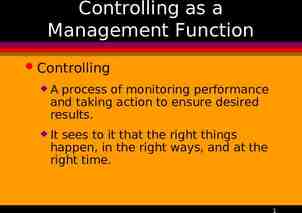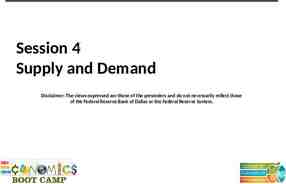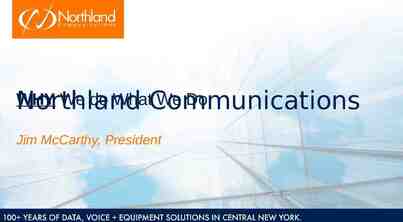Chapter 3 Standards for Decision Making Muchinsky 12th Ed. Psychology
20 Slides1.34 MB

Chapter 3 Standards for Decision Making Muchinsky 12th Ed. Psychology Applied to Work 1

Learning Objectives Conceptual and actual criteria. Criterion deficiency, relevance, and contamination. Work analysis and the job analysis methods. Nine major criteria of job performance The concept of dynamic criteria. Psychology Applied to Work 2

Criteria Evaluative standards Criterion issues have major significance in I/O psychology Disagreements and discrepancies occur in: Choices over the proper criteria to use Disagreements about their definition Psychology Applied to Work 3

Conceptual vs. Actual Criteria Conceptual Criterion (theoretical) Actual Criteria (empirical measures) What’s the difference? Psychology Applied to Work 4

Criterion Deficiency, Relevance, & Contamination Criterion Deficiency How much actual criteria FAIL to overlap conceptual criteria Can reduce but not eliminate all deficiency Criterion Relevance How much actual criteria and conceptual criteria coincide Some examples for your job? Psychology Applied to Work 5

Criterion Deficiency, Relevance, & Contamination (cont’d) Psychology Applied to Work 6

Criterion Deficiency, Relevance, & Contamination (cont’d) Criterion Contamination Unrelated to the conceptual criteria – two parts: Bias – extent actual criteria consistently measures something else Error – how much actual criteria are related to nothing at all Both distort the conceptual criterion Can be controlled statistically to some degree Examples of bias and error from your job? Psychology Applied to Work 7

Work Analysis / Job Analysis: What’s the difference? Procedure to: identify criteria in job performance by documenting: Work content Work attributes Work context Examples from your job? Psychology Applied to Work 8

Work Analysis Psychology Applied to Work 9

Sources of Work Information SME (Subject Matter Expert) Job incumbent Job supervisor (Trained) Work Analyst Who would you choose for your job? Psychology Applied to Work 10

Work Analytic Procedures Task-Oriented Procedures Examines work activities Discrete units of work (what is accomplished) Incumbents rate tasks on various dimensions (frequency, importance) Classic example is Functional Job Analysis (FJA) SMEs rates work on three dimensions: Things, Data, and People Often used in federal government Psychology Applied to Work 11

Work Analytic Procedures (cont’d) Worker-Oriented Procedures Examines human attributes -what are some for your job? K –knowledge – types of information needed S – skills – proficiencies need that can be practiced A – abilities – relatively enduring innate proficiencies O – other – personality or capacities Linkage Analysis unites task-oriented and workeroriented information Psychology Applied to Work 12

Procedures for Collecting Information Interview (of SMEs) Can (often) exaggerate the importance of their tasks Why would they do this! Direct observation of employees Identifies work conditions; helps to understand the context Questionnaires/inventories (commercially available) Psychology Applied to Work 13

Taxonomic Information (examples) know these! Position Analysis Questionnaire (PAQ) Compares job to an existing data base of jobs Examines relationships among a set of jobs Primarily to help determine pay scales Fleishmann’s method Describes job tasks performed and KSAOs needed Classifies jobs based on requisite human abilities O*NET (U.S. Department of Labor) – you know O*Net! based on thousands of jobs series of instruments to assess skills and interests labor market information multiple levels of analysis and applications Psychology Applied to Work 14

Managerial Work Analysis Managerial work is less directly observable (why?) Two instruments to analyze these jobs: Professional and Managerial Position Questionnaire Personality-Related Position Requirements Form Psychology Applied to Work 15

Uses of Work Analytic Information Rationale for personnel selection tests Organizes positions into job families to help determine compensation levels Provides information for content of training needed Provides basis for content of performance appraisal Can be used in vocational counseling – selection (O*NET) Can help with ADA criteria for career reasonable accommodation Psychology Applied to Work 16

Evaluating Work Analytic Information Some findings: No one method is the best Knowledgeable raters make a big difference in rating accuracy Task-oriented methods have less error than worker-oriented (why?) (tasks are more discrete and observable) .as opposed to? - Opinions, subjective judgments about abilities and attributes needed (some examples?) Psychology Applied to Work 17

Competency Modeling (CM) Core competency is a critically important KSAO What is one or two?. For you organization? CM: Does NOT consider the work performed CM: Meant to cover the all employees CMs are abstract and don’t differentiate jobs like KSAOs do Tries to link employee’s personal qualities to company mission (fit) Has little precision/rigor but has populist appeal Psychology Applied to Work 18

Job Performance Criteria 1. 2. 3. 4. 5. 6. 7. 8. 9. Production Sales Tenure or Turnover Absenteeism Accidents Theft Counterproductive (deviant) Work Behavior Adaptive and Citizenship Behavior Emotional Labor what is this? 1. 2. Onerous duty (“toil) What are display rules? 1. Outward expressions: Real or fake? (smile, eye contact etc.) which criterion is most difficult to measure? Psychology Applied to Work 19

Dynamic Performance Criteria Employees have different learning curves This is a critical issue when trying to predict (short/long term) success Psychology Applied to Work 20






